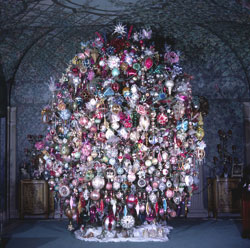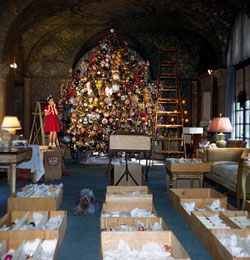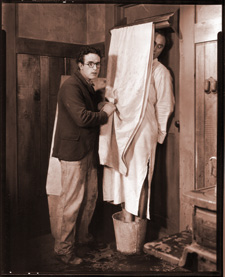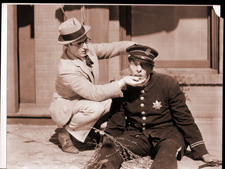For the first time ever on DVD:
HAROLD LLOYD COLLECTION
(9 Discs)
Out to own on DVD 9th July2007
With Brand New Orchestral Scores,
Fully Restored & Digitally Re-Mastered
Feat ures:
ures:
Safety Last!
Girl Shy
The Cat’s Paw
The Milky Way
Why Worry?
Dr. Jack
Feet First
Kid Brother
Hot Water
Speedy
Grandma’s Boy
A Sailor Made Man
For Heaven’s Sake
Movie Crazy
Welcome Danger
The Freshman
Short films:
Bumping Into Broadway
Ask Father
From Hand to Mouth
Billy Blazes Esq
Now or Never
High and Dizzy
Get Out And Under
Never Weaken
Haunted Spooks
Number Please?
Among Those Present
I Do
PLUS More Exclusive Extras
Harold Lloyd was one of the great comic stars of the cinema, a genius on a par with Chaplin and Keaton. Born in Burchard, Nebraska, on April 20, 1893 Lloyd was acting at an early age with theatrical repertory companies. He made his film debut as an extra in a 1913 one-reel film for the Edison Film Company. He became friends with another extra, Hal Roach, and when Roach formed his own film company, he invited Lloyd to join him.
Lloyd’s initial comic characterization was a tramp character called Willie Work. After a series of partings over money and subsequent reconciliations, Roach and Lloyd created a new character, called Lonesome Luke, which became popular, despite Lloyd’s dislike of imitating Charlie Chaplin, which the film distributor, Pathé, demanded.
Then Lloyd found the idea that was to become his trademark, and change him from a good comedian to a major star: the glasses. Lloyd persuaded Roach and his distributor to abandon Lonesome Luke and in 1917 Lloyd shed grotesque comedy clothes and characterizations for a pair of horn-rimmed glasses. In doing so, Lloyd created an American archetype, an optimistic and determined go-getter sporting spectacles and a toothy smile.
Lloyd retained the “Glass Character” (as Lloyd called his comic persona) throughout the rest of his motion picture career, which spanned 34 years and over 200 comedies. Among his most famous films are Grandma’s Boy (1922), Safety Last! (1923), The Freshman (1925), The Kid Brother (1927), Speedy (1928), and Movie Crazy (1932), all included here amongst many other gems in this most comprehensive of collections.
Cert: PG tbc
Total Running Time: 1746 mins approx
Aspect Ratio: 1.33:1
B&W / Pal
Region 2
English Language / Mono
Catalogue No: OPTD00705
RRP: £49.99
DISC 1 – SAFETY LAST! / GIRL SHY
Shorts: AN EASTERN WESTERNER (24 mins)
Extras: Safety Last! Commentary, Mini Biographies (29 mins)
SAFETY LAST! (1923)
Producer: Hal Roach Directors: Fred Newmeyer and Sam Taylor
Harold Lloyd’s most-famous comedy features him as a sales clerk in a department store who finds himself hanging off the hands of a collapsing clock on the side of a skyscraper high above the streets of downtown Los Angeles. Harold’s legendary building climb is breathtaking—and hilariously funny—at the same time. What is even more amazing is that the sequence was achieved without any rear-screen projection or special effects. Lloyd was just as high above ground as one sees him in the film. The fourth—and best—of Lloyd’s five famous “thrill” comedies.
Feature running time: 73 mins approx
Feature Aspect ratio: 1.33:1
Silent Film
Audio: Mono
GIRL SHY (1924)
Producer: Harold Lloyd Directors: Fred Newmeyer and Sam Taylor
Harold is a shy tailor’s apprentice who has a pronounced stutter and is afraid of girls. He spends his lonely evenings writing a book called The Secret of Love Making until he is galvanized into action when he discovers that the girl he loves (Jobyna Ralston) is about to marry a bigamist. What follows is arguably the greatest race-to-the-rescue sequence of the entire silent cinema. The film’s ending was the inspiration for Mike Nichol’s The Graduate (1967) over forty years later. One of Lloyd’s most influential and important films.
Feature running time: 80 mins approx
Feature Aspect ratio: 1.33:1
Silent Film
Audio: Mono
DISC 2 – THE CAT’S PAW / THE MILKY WAY
Extras: Harold’s Hollywood Featurette (8 mins)
THE CAT’S PAW (1934)
Producer: Harold Lloyd Director: Sam Taylor
Born to an American missionary in China, Harold comes back to the USA as a total innocent and finds himself accidentally involved in a ferocious war between local Chinese tongs. The town politicians see him a perfect tool and he is persuaded to run for Mayor. They think he will be putty in their hands but, in a complete turnaround at the end, he proves to be quite the contrary.
Feature running time: 102 mins approx
Feature Aspect ratio: 1.33:1
Audio: Mono
THE MILKY WAY (1936)
Producer: E. Lloyd Sheldon Director: Leo McCarey
Timid milkman, Burleigh Sullivan (Lloyd), somehow knocks out a boxing champ in a brawl. The fighter’s manager decides to build up the milkman’s reputation in a series of fixed fights and then have the champ beat him to regain his title.
Feature running time: 88 mins approx
Feature Aspect ratio: 1.33:1
Audio: Mono
DISC 3 – WHY WORRY? / DR.JACK / FEET FIRST
WHY WORRY? (1923)
Producer: Hal Roach Directors: Fred Newmeyer and Sam Taylor
Harold plays wealthy hypochondriac Harold van Pelham, who travels with his private nurse (Jobyna Ralston) to the fictious island of Paradiso to live blissfully in a warm climate in order to regain his health. In Paradiso, he finds himself in the middle of a revolution, which Harold assumes is being staged as an entertainment for his amusement. With the aide of an eight feet nine inch giant named Colosso (Johan Aasen), Harold crushes the rebellion and the excitement cures him of his imagined ailments. Why Worry? is unquestionably on of Lloyd’s most hilarious comedies.
Feature running time: 63 mins approx
Feature Aspect ratio: 1.33:1
Silent Film
Audio:
DR. JACK (1922)
Producer: Hal Roach Director: Fred Newmeyer
Harold plays Dr. Jackson (Dr. Jack for short), a small-town doctor who is a friend to everyone and eager to help. He approaches the healing of his patients through psychology and the nontraditional means of joy and excitement rather than medicine. Dr. Jack comes to the rescue of the Sick-Little-Well-Girl (Mildred Davis) who is deliberately coddled by her quack doctor (Eric Mayne).
Feature running time: 59 mins approx
Feature Aspect ratio: 1.33:1
Silent Film
Audio: Mono
FEET FIRST (1930)
Producer: Harold Lloyd Director: Clyde Bruckman
Harold plays Harold Horne, an ambitious Honolulu shoe clerk determined to make his way into the ranks of high society. He becomes a stowaway aboard a ship while masquerading as a successful businessman, and manages to be accidentally flown to shore by seaplane while hiding in a mailbag. The mailbag is accidentally dropped on a painter’s scaffold that starts ascending the façade of a downtown Los Angeles office building. The mailbag gets caught on an awning hook, which leaves it—and Harold—suspended several stories above ground. Ignorant of his location, Harold cuts his way out of the mailbag, is horrified to discover his predicament, and is forced to blimb the building. Feet First was Lloyd’s fifth and final “thrill” picture, designed to recapture the thrills of the silent-film Safety Last! with sound.
Feature running time: 90 mins approx
Feature Aspect ratio: 1.33:1
Audio: Mono
DISC 4 – THE KID BROTHER
Shorts: BUMPING INTO BROADWAY (25 mins) / BILLY BLAZES, ESQ. (13 mins)
Extras: Home Movies (28 mins), Leonard Maitlin Featurette (20 mins)
THE KID BROTHER (1927)
Producer: Harold Lloyd Directors: Ted Wilde and J.A.Howe
The Kid Brother is Harold Lloyd’s masterpiece and Lloyd’s favourite of all his films. Harold is a country boy who is the “Cinderella” of the Hickory family. Shy and bespectacled, his wit and ingenuity are not appreciated by his physically robust but none-too-bright father and brothers. When Mary arrives with the traveling road show, Harold needs all his quick wits and courage to defeat the villains, win the girl of his dreams and finally gain his father’s approval.
Feature running time: 81 mins approx
Feature Aspect ratio: 1.33:1
Silent Film
Audio: Mono
DISC 5 – HOT WATER
Shorts: NOW OR NEVER (35 mins) / HIGH AND DIZZY (26 mins) / GET OUT AND GET UNDER (25 mins)
Extras: Greenacres Featurette (15 mins), Remembering Harold Featurette (11 mins), Keep ‘Em Rolling Featurette (15 mins), Finding Harold Featurette (3 mins)
HOT WATER (1924)
Producer: Harold Lloyd Directors: Sam Taylor and Fred Newmeyer
A hilarious domestic-life comedy begins with Harold with an armful of packages and a live turkey on a streetcar, followed by a disastrous spin in his new car with his in-laws, and ending with haunted house-type thrills provoked by his mother-in-law (Josephine Crowell).
Feature running time: 59 mins approx
Feature Aspect ratio: 1.33:1
Silent Film
Audio: Mono
DISC 6 – SPEEDY / GRANDMA’S BOY
Shorts: NEVER WEAKEN (29 mins) / HAUNTED SPOOKS (25 mins)
SPEEDY (1928)
Producer: Harold Lloyd Director: Ted Wilde
Speedy, Lloyd’s last silent film, is a superb valedictory to the silent era. “Speedy” was Harold’s real-life nickname (given to him by his father) and the film is appropriately fast-paced. Lloyd plays Harold “Speedy” Swift, a baseball-crazy young man who cannot hold a job. His employment misadventures include work as a soda jerk and a cab driver. Harold’s girlfriend, Jane (Ann Christy), lives with her grandfather, “Pop” Dillon (Bert Woodruff), who owns New York City’s last horse-drawn streetcar. A gang hired by a railroad monopoly steals the horse and streetcar. By stopping Pop’s streetcar from operating more than twenty-four hours, the rail monopoly hopes to steal away his franchise. Speedy ultimately finds the car and manages to get it back on track in time to make the daily run, saving Pop’s franchise. Filmed partly on location in New York, the film features a memorable cameo from baseball legend Babe Ruth and a wild chase scene in downtown Manhattan, where Harold must hurtle the horse-drawn streetcar pell-mell through chaotic city traffic.
Feature running time: 86 mins approx
Feature Aspect ratio: 1.33:1
Silent Film
Audio: Mono
GRANDMA’S BOY (1922)
Producer: Hal Roach Director: Fred Newmeyer
Harold is a cowardly young man who runs to his grandmother (Anna Townsend) out of fear when he is asked to participate in the manhunt for a tramp (Dick Sutherland) who has killed a man. The boy finds the courage only after his wise granny gives him a magic talisman that she tells him had helped his equally timid grandfather become a hero in the Civil War. Only after Harold single-handedly captures the killer does his grandmother tell him the truth—the talisman was a fake, nothing more than an old umbrella handle. Harold always had the courage inside him; he just had to find it for himself—a classic Lloyd lesson. The film ends with Harold ridding himself of a bully (Charles Stevenson) and proposing to his girl (Mildred Davis). The film’s brilliantly integrated plot and gags made Grandma’s Boy one of the most influential of silent feature-length comedies. Upon its release Charlie Chaplin called it “one of the best-constructed screenplays I have ever seen” and elements of the film can be seen in Buster Keaton’s masterpiece, The General (1926).
Feature running time: 56 mins approx
Feature Aspect ratio: 1.33:1
Silent Film
Audio: Mono
DISC 7
Features: A SAILOR-MADE MAN / FOR HEAVEN’S SAKE
Shorts: NUMBER, PLEASE? (25 mins) / AMONG THOSE PRESENT (35 mins) / I DO (24 mins)
A SAILOR-MADE MAN (1921)
Producer: Hal Roach Director: Fred Newmeyer
Harold is introduced as “The Boy—Idle heir to twenty millions—And a nerve that would blunt the edge on forked lightning.” At the country club, he gets the attention of a popular girl (Mildred Davis) by saying, “It’s too hot to play croquet; let’s get married.” When she tells Harold he must first ask her father, the father tells Harold that he will not allow her to marry him until he makes something of himself; so Harold joins the navy in order to impress the girl and her father. Stationed in the fictitious kingdom of Khairpura-Bhandanna, he rescues Davis (whose yacht has also arrived there) from the villainous maharajah (Dick Sutherland) and his army of sword-wielding warriors in the film’s frantic climax. Safely back aboard their respective ship and yacht, Harold proposes to his girl using semaphore, and she accepts. Originally intended as a two-reel comedy short, A Sailor-Made Man proved popular in previews in a four-reel rough cut and became Lloyd’s unintentional first feature-length film.
Feature running time: 46 mins approx
Feature Aspect ratio: 1.33:1
Silent Film
Audio: Mono
FOR HEAVEN’S SAKE (1926)
Producer: Harold Lloyd Director: Sam Taylor
Lloyd plays J. Harold Manners, a millionaire playboy who inadvertently contributes to a skid row mission (which is then named in his honor). He meets and falls in love with Hope (Jobyna Ralston), the mission pastor’s daughter, when he visits the mission to protest his name being used. Under her influence, Manners makes parishioners out of all the seedy characters and tough men of the neighborhood. When his idle club friends abduct him on his wedding day (believing they are preventing him from making a foolish mistake), Harold (with his inebriated groomsmen in tow) must race back to the mission so as not to miss his own wedding. The race-to-the-rescue sequence that climaxes For Heaven’s Sake on the double-decker open-top bus is one of Lloyd’s most memorable sequences.
Feature running time: 57 mins approx
Feature Aspect ratio: 1.33:1
Silent Film
Audio: Mono
DISC 8 – MOVIE CRAZY / WELCOME DANGER
Extras: From the Vault (47 mins)
MOVIE CRAZY (1932)
Producer: Harold Lloyd Director: Clyde Bruckman
Harold Lloyd’s best sound film has him portraying Harold Hill, a small-town Kansas rube who dreams of making it in the movies. Upon his arrival in Hollywood, Harold manages to wreak havoc as soon as he steps off the train. He falls in love with a beautiful Spanish actress, failing to recognize that she is the same young woman, without makeup and wig, who later gives him a ride home in the rain. Mary Sears (Constance Cummings) keeps the two identities concealed from Harold and has him play the fool. Harold the lamb turns into Harold the lion in the film’s elaborate fight sequence on the set of a flooding boat in the film’s memorable climax. The film is also notable for the comedy sequence of Harold unknowingly wearing a magician’s coat at a formal dinner party, causing chaos with the small creatures that emerge from his jacket sleeves.
Feature running time: 96 mins approx
Feature Aspect ratio: 1.33:1
Audio: Mono
WELCOME DANGER (1929)
Producer: Harold Lloyd Director: Clyde Bruckman
Lloyd plays botanist Harold Bledsoe, who is summoned to San Francisco where his late father had once been chief of police. His father’s colleagues desperately hope he is a chip off the old block and take the extreme measure of making him police chief to thwart the flourishing crime of the Chinatown underground led by the Dragon (Charles Middleton). Despite his lack of experience, as well as botanical and female (Barbara Kent) distractions, Harold nevertheless corners the Dragon and forces him to confess his crimes in front of the entire police force. Harold’s first sound motion picture was also his greatest commercial success. However, Lloyd was uneasy about the quality of the film in later years; he believed that the film—at 12 reels—was far too long for a comedy.
Feature running time: 114 mins approx
Feature Aspect ratio: 1.33:1
Audio: Mono
DISC 9 – THE FRESHMAN
Shorts: FROM HAND TO MOUTH (22 mins) / ASK FATHER (13 mins)
THE FRESHMAN (1925)
Producer: Harold Lloyd Directors: Sam Taylor and Fred Newmeyer
Harold Lloyd’s most popular comedy is arguably his funniest film. It was also his most commercially successful silent comedy feature. Harold plays college freshman Harold Lamb who longs to be the Big Man on Campus. His metamorphous from college zero to college hero in the climactic football game is one of the high points of silent film comedy.
Feature running time: 76 mins approx
Feature Aspect ratio: 1.33:1
Silent Film
Audio: Mono
 It took from Thanksgiving until Christmas to decorate the tree. Over the years, my grandfather had collected thousands of ornaments from all over the world. The tree held one-of-a-kind rare ornaments valued in the hundreds of dollars when they were first purchased in the `30’s and `40’s. The tree also held homemade ones that Harold received from his charity work.
It took from Thanksgiving until Christmas to decorate the tree. Over the years, my grandfather had collected thousands of ornaments from all over the world. The tree held one-of-a-kind rare ornaments valued in the hundreds of dollars when they were first purchased in the `30’s and `40’s. The tree also held homemade ones that Harold received from his charity work. One Christmas, I was with Daddy shopping for more ornaments in Saks Fifth Avenue. He plucked more and more ornaments off the store’s white-flocked display tree unable to decide which ones to purchase. Finally, he realized that every ornament on the tree would look nice at Greenacres and quickly decided right then and there to buy them all. Since there was no room on the tree at home, his impulse purchase had to include Sak’s white-flocked display tree as well! So the 12 foot, completely decorated tree, was shipped off to Greenacres and found a home in our front entrance hall. I have no idea where Saks put their presents that year after Harold left a gapping hole in their Christmas display.
One Christmas, I was with Daddy shopping for more ornaments in Saks Fifth Avenue. He plucked more and more ornaments off the store’s white-flocked display tree unable to decide which ones to purchase. Finally, he realized that every ornament on the tree would look nice at Greenacres and quickly decided right then and there to buy them all. Since there was no room on the tree at home, his impulse purchase had to include Sak’s white-flocked display tree as well! So the 12 foot, completely decorated tree, was shipped off to Greenacres and found a home in our front entrance hall. I have no idea where Saks put their presents that year after Harold left a gapping hole in their Christmas display. One year we counted over 5,000 ornaments hanging from the tree and we still had enough left over to decorate 3 more trees just as big! Every year the tree grew larger to hold more ornaments; then one year it became a permanent fixture in our home. It was simply too large, too decorated and too engineered to disassemble. So we had it fireproofed and celebrated Christmas every day of the year!
One year we counted over 5,000 ornaments hanging from the tree and we still had enough left over to decorate 3 more trees just as big! Every year the tree grew larger to hold more ornaments; then one year it became a permanent fixture in our home. It was simply too large, too decorated and too engineered to disassemble. So we had it fireproofed and celebrated Christmas every day of the year!
 It is widely known that, in the early days of television, Harold Lloyd was reluctant to allow his films to be shown in this medium, due to stricter time slots, choppy editing and commercial breaks which interrupt story flow. Lloyd felt, and rightly so, that his films need to be seen in their entirety, undisturbed and uncut. However, I feel (and if I might be so bold as to put words in the great man’s mouth) that Harold would wholly embrace cable TV, with its more comfortable scheduling, and its ability to show a film without interruption; for similar reasons, he’d love DVD. As such, I think he would be mighty happy about the way his films are being reintroduced to new generations. He would, no doubt, be thrilled that new audiences are finding out what Lloyd aficionados already know – my top three reasons why Harold Lloyd is important.
It is widely known that, in the early days of television, Harold Lloyd was reluctant to allow his films to be shown in this medium, due to stricter time slots, choppy editing and commercial breaks which interrupt story flow. Lloyd felt, and rightly so, that his films need to be seen in their entirety, undisturbed and uncut. However, I feel (and if I might be so bold as to put words in the great man’s mouth) that Harold would wholly embrace cable TV, with its more comfortable scheduling, and its ability to show a film without interruption; for similar reasons, he’d love DVD. As such, I think he would be mighty happy about the way his films are being reintroduced to new generations. He would, no doubt, be thrilled that new audiences are finding out what Lloyd aficionados already know – my top three reasons why Harold Lloyd is important. More on that in a moment. However, in breaking from the norm, by revolutionizing comedy, by presenting a persona who was not engrained in his time, Lloyd created films that are not as dated as some others of his era. Sure, the cars in his films are of his time; the architecture, the furnishings, the situations scream of long ago – but Lloyd’s Glass Character, in looking like us, doesn’t instantly invoke thoughts of generations past. And, in so doing, his humor – the situations he found himself in, and his demeanor in facing them – is still funny. Which leads me to something Harold noted earlier …
More on that in a moment. However, in breaking from the norm, by revolutionizing comedy, by presenting a persona who was not engrained in his time, Lloyd created films that are not as dated as some others of his era. Sure, the cars in his films are of his time; the architecture, the furnishings, the situations scream of long ago – but Lloyd’s Glass Character, in looking like us, doesn’t instantly invoke thoughts of generations past. And, in so doing, his humor – the situations he found himself in, and his demeanor in facing them – is still funny. Which leads me to something Harold noted earlier … It can be generally noted that most, if not all, of the Lloyd films (even most of the shorts, and the sound features as well) have keen optimism as their centerpiece. Harold Lloyd, in his Glass Characterizations, believes that he can overcome whatever obstacle is thrown his way, and faces adversity with fervor and passion. He smiles a lot; we like him, and on the whole, we can see why others like him too. He catches the gaze of females – for many women, he’s perceived as a good catch – his upbeat demeanor and confidence are inspiring. My husband (Scott Lloyd) once noted to me how Harold Lloyd embodied the type of man who he’d like to grow up to be: “I was never quite as optimistic, brave, courteous, funny, or courageous as Harold was in his films,” wrote Scott to me in 1997, “but he became an icon and was always a symbol of the type of person I wanted to be. A fundamental thing our society lacks today is a body of positive role models for young people. Harold was that role model for me and it affected my life deeply.”
It can be generally noted that most, if not all, of the Lloyd films (even most of the shorts, and the sound features as well) have keen optimism as their centerpiece. Harold Lloyd, in his Glass Characterizations, believes that he can overcome whatever obstacle is thrown his way, and faces adversity with fervor and passion. He smiles a lot; we like him, and on the whole, we can see why others like him too. He catches the gaze of females – for many women, he’s perceived as a good catch – his upbeat demeanor and confidence are inspiring. My husband (Scott Lloyd) once noted to me how Harold Lloyd embodied the type of man who he’d like to grow up to be: “I was never quite as optimistic, brave, courteous, funny, or courageous as Harold was in his films,” wrote Scott to me in 1997, “but he became an icon and was always a symbol of the type of person I wanted to be. A fundamental thing our society lacks today is a body of positive role models for young people. Harold was that role model for me and it affected my life deeply.” ures:
ures: